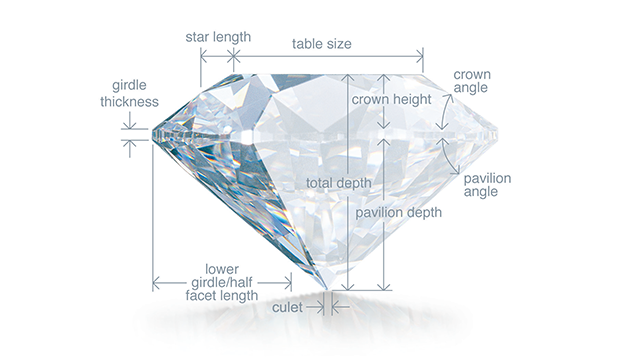Recently added item(s)
No products
Recently added item(s)
No products
Various characteristics of diamonds are graded and categorized by the diamond industry. Learning about diamonds is first learning about the "four Cs" of diamonds which are considered the most important grades and categories
Cut refers to the overall finish and proportions of a diamond, and how these factors affects its overall appearance.
Diamond cut is perhaps the most important of the four Cs. A good cut gives a diamond its brilliance, which is that brightness that seems to come from the very heart of a diamond. The angles and finish of any diamond are what determine its ability to handle light, which leads to brilliance.
As shown in the images below, when a diamond is well-cut, light enters through the table and travels to the pavilion where it reflects from one side to the other before reflecting back out of the diamond through the table and to the observer’s eye. This light is the brilliance we mentioned, and it’s this flashing, fiery effect that makes diamonds so mesmerizing.
In a poorly cut diamond, the light that enters through the table reaches the facets and then ‘leaks’ out from the sides or bottom of the diamond rather than reflecting back to the eye. Less light reflected back to the eye means less brilliance.


When we speak of a diamond’s clarity, we are referring to the presence of identifying characteristics on (blemishes) and within (inclusions) the stone. Basically there are two types of flaws: inclusions and blemishes. Inclusions refer to internal flaws and blemishes refer to surface flaws.
Inclusions include flaws such as air bubbles, cracks, and non-diamond minerals found in the diamond. Blemishes include scratches, pits, and chips. Some blemishes occur during the cutting processes (most often at the girdle). Diamonds with no or few inclusions and blemishes are more highly valued than those with less clarity because they are rarer. You can divide the clarity of a diamond in 5 categories:

While the presence of these characteristics do lower the clarity grade of a diamond, they can also be viewed as proof of a diamond’s identity. Most Certificates include what is known as a map of a diamond’s inclusions — think of it as a “diamond fingerprint.” Since no two diamonds are exactly the same, comparing the uniqueness of your diamond’s clarity characteristics with the “map” provided on the diamond certificate offers assurance that the diamond you pay for is the same diamond you receive.
When we speak of a diamond’s color, we are usually referring to the presence or absence of color in white diamonds. Color is a result of the composition of the diamond, and it never changes over time. Colors over Z are graded as fancy color diamonds and are very rare and very expensive. Diamonds of all colors can be found in nature. They are actually more valuable for their color than white diamonds. To grade ‘whiteness’ or colorlessness, most jewelers refer to GIA’s professional color scale that begins with the highest rating of D for colorless, and travels down the alphabet to grade stones with traces of very faint or light yellowish or brownish color. The color scale continues all the way to Z.

And while a very, very faint hint of yellow will be apparent in diamonds graded J through M, this color can often be minimized by carefully selecting the right jewelry in which to mount your diamond. Keep in mind that, while most people strive to buy the most colorless diamond they can afford, there are many people who actually prefer the warmer glow of lower-color diamonds.
What is Fluorescence?
Fluorescence is an effect that is seen in some gem-quality diamonds when they are exposed to long-wave ultraviolet light (such as the lighting frequently seen in dance clubs). Under most lighting conditions, this fluorescence is not detectable to the eye. While most gemologists prefer diamonds without this effect, some people enjoy it. It’s really just a matter of aesthetics.
A carat is a unit of measurement, it is the unit used to weigh a diamond. One carat is equal to 200 milligrams or 1/5 of a gram.
For Diamonds weighing less than a carat their weight is expressed in “points” each carat is divided into 100 points. For example:
0.75ct. = 75 points
1/2ct. = 50 points
1/4 ct. = 25 points.
Don’t confuse “carat weight” with “karat,” the method of determining the purity of gold. The process that forms a diamond happens only in very rare circumstances, and typically the natural materials required are found only in small amounts. That means that larger diamonds are mined less often than smaller ones. Thus, large diamonds are rare and have a greater value per carat. For that reason, the price of a diamond rises proportionately with its size.

NY Office:
62 West 47th Street, Suite 1508, NY, NY 10036
Israel office:
Diamond Bourse
21, Tuval Street,
52521, Ramat Gan
WhatsApp: +972 543 974 594

